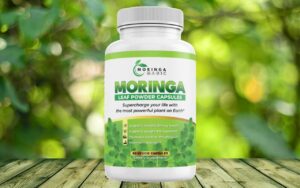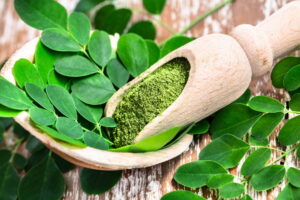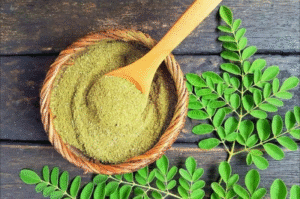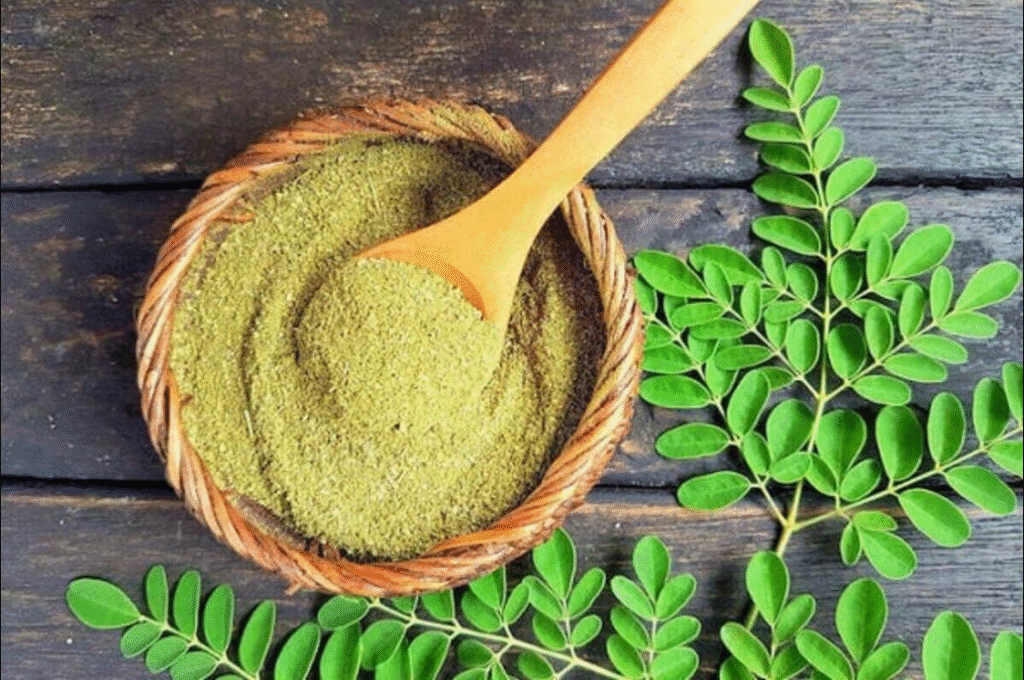
If you’ve heard people call moringa the “miracle tree,” there’s a reason. Moringa oleifera, a fast-growing tree native to parts of Asia and Africa, has leaves, pods, seeds, and even roots that have been used for centuries in food and traditional medicine. Today, research and nutrition data are catching up, giving us a clearer picture of what moringa does well and where you should be cautious.
In this guide, you’ll learn:
- What makes moringa so nutrient-dense
- How it may support immunity, energy, and blood sugar balance
- Ways moringa can benefit skin and hair
- Practical tips on dosing and forms (powder, capsules, tea, oil)
- Risks, interactions, and who should be cautious
Quick Overview: What Is Moringa?
Moringa oleifera is sometimes called drumstick tree or horseradish tree. The edible parts most people use are the leaves (fresh, dried, or powdered) and seeds (pressed into oil). Leaves deliver a broad range of vitamins, minerals, amino acids, and antioxidants in a small serving. Because it’s hardy and nutrient-rich, moringa is a staple in community nutrition programs in several countries.
The Nutritional Power of Moringa
A compact source of vitamins and minerals
Moringa leaves provide:
- Vitamin C: Supports immune function and collagen production.
- Vitamin A (as beta-carotene): Aids vision, skin integrity, and immune defense.
- Vitamin K: Supports normal blood clotting and bone health.
- B vitamins (including folate): Help with energy metabolism and red blood cell formation.
- Minerals like calcium, potassium, iron, and magnesium: Important for bone strength, muscle function, oxygen transport, and nerve signaling.
Serving sizes vary by brand, but a typical 2-teaspoon (about 10 g) serving of moringa leaf powder can deliver meaningful amounts of vitamin A, vitamin C, calcium, and iron. While moringa isn’t a perfect replacement for a balanced diet, it can bolster nutrient intake, especially when fruit and vegetable variety is limited.
Complete amino acids (rare for a plant)
Moringa leaves contain all nine essential amino acids. That’s useful for plant-forward eaters who want support for muscle repair, enzyme production, and overall protein quality. You still need enough total protein across the day, but moringa contributes to a complete amino acid profile.
Antioxidants that help manage oxidative stress
Moringa is rich in polyphenols and other antioxidant compounds such as quercetin and chlorogenic acid. These molecules help neutralize free radicals, which can damage cells over time. Diets higher in antioxidant-rich foods are linked with better cardiovascular and metabolic health. Moringa won’t replace fruits and vegetables, but it can add to your total antioxidant intake.
Immune-Boosting Benefits

Nutrients that fortify your defenses
- Vitamin C and A work together to support mucosal barriers (like the lining of your nose and lungs) and help immune cells function well.
- Iron supports the development of immune cells and helps your body move oxygen efficiently, which matters during recovery.
Anti-inflammatory support
Low-grade inflammation can make your immune system less effective. Plant compounds in moringa, including isothiocyanates and flavonoids, have been studied for their potential to modulate inflammatory pathways. While moringa isn’t a medicine for infections, including it in a balanced diet may support a healthier baseline immune response.
Everyday wellness support
People who add moringa to smoothies, soups, or teas often report steadier energy across the day. That’s likely due to a mix of B vitamins, iron, and phytonutrients. If your energy dips are tied to low iron or a limited intake of leafy greens, moringa can be a practical add-on.
Metabolic and Heart Health Support
Blood sugar balance
Early research suggests moringa may help reduce post-meal blood sugar spikes. Compounds in the leaves can slow carbohydrate breakdown and improve insulin signaling in some cases. Practical tip: pairing a small serving of moringa powder with carb-heavy meals may blunt sharp rises in glucose. This is supportive, not a replacement for prescribed therapies.
Lipid profile and blood pressure
Preliminary findings point to potential improvements in LDL cholesterol and triglycerides when moringa is consumed regularly, along with possible support for healthy blood pressure. The combination of antioxidants, potassium, and anti-inflammatory compounds likely drives these benefits. As always, gains are strongest when moringa is part of a broader pattern: fiber-rich foods, movement, and adequate sleep.
Skin and Hair Benefits
Nutrients for glow and resilience
- Vitamin A supports skin cell turnover and barrier function.
- Vitamin C helps your body build collagen, the protein that keeps skin firm and elastic.
- Antioxidants in moringa help buffer environmental stressors that can dull skin.
Moringa oil (topical)
Pressed from moringa seeds, moringa oil (also called ben oil) is light, stable, and rich in oleic acid and antioxidants. It:
- Absorbs quickly and helps soften dry or flaky skin
- Can support a smoother skin texture
- Works well as a carrier oil for essential oils or serums
Many people use a few drops after cleansing, especially at night. Patch test first to rule out sensitivity.
Scalp and hair
A balanced scalp supports hair growth. The fatty acids and vitamin E in moringa oil can help moisturize the scalp and reduce dryness. A light massage with a few drops once or twice a week is usually enough. Avoid heavy application that can clog pores.
Digestive and Liver Support
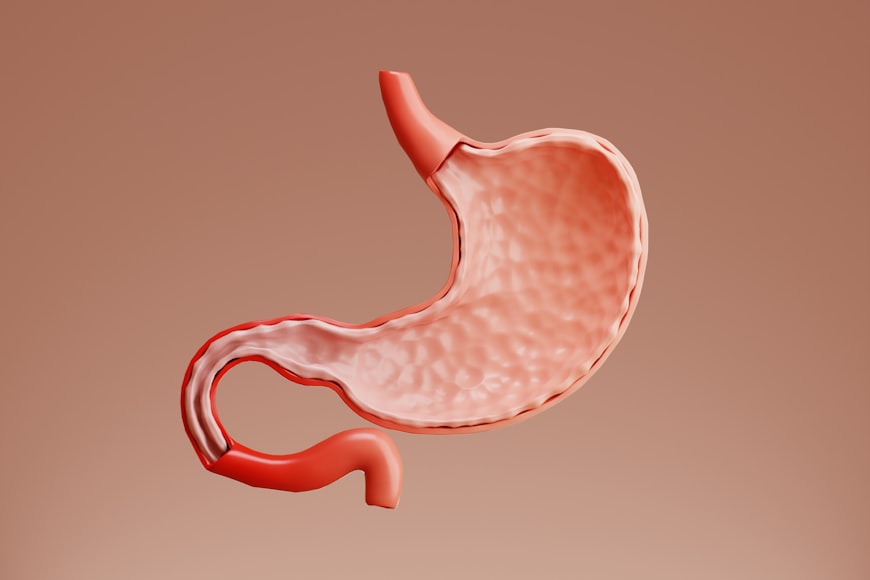
Gentle support for digestion
Moringa’s fiber content (in whole leaf or powder form) can aid regularity and feed beneficial gut bacteria. If you’re new to high-fiber foods, start small to avoid gas or bloating. Moringa tea is a low-fiber option with milder digestive effects.
Liver protection (early evidence)
Animal and cell studies suggest moringa’s antioxidants may help protect liver cells from oxidative stress. While this is promising, human studies are still limited. Consider moringa as supportive nutrition rather than a liver “detox.”
How to Use Moringa
Forms you’ll see
- Leaf powder: The most common. Add to smoothies, yogurt, oatmeal, soups, or sauces.
- Capsules/tablets: A mess-free option if you dislike the taste.
- Tea: Mild and easy to sip. Lower dose than powder.
- Fresh leaves/pods: Used in cooking where available.
- Oil: For skin and hair, not typically used as a dietary oil.
Taste and cooking tips
Moringa leaf powder has an earthy, slightly peppery taste somewhere between matcha and spinach.
- Smoothies: Blend 1 teaspoon with banana, pineapple, or mango for a pleasant flavor.
- Savory: Stir into soups, curries, or eggs after cooking to preserve nutrients.
- Baking: Mix small amounts into muffins or energy bites.
Suggested amounts
There is no universal daily dose, but common ranges for leaf powder are:
- Start: 1/2 to 1 teaspoon (1–2 g) per day
- Typical: 2–4 teaspoons (4–8 g) per day, split across meals
- Capsules often provide 400–1000 mg per capsule; follow the label
Increase gradually and watch how you feel. If you take medications or have a health condition, check with your clinician before using higher amounts.
Who Might Benefit Most?
- People aiming to increase nutrient density on a budget
- Plant-forward eaters who want complete amino acids
- Individuals seeking gentle support for blood sugar and cholesterol (alongside medical care)
- Those looking for a simple, antioxidant-rich add-in for overall wellness
- People with dry or sensitive skin who want a light, stable oil
Things to Be Mindful Of: Risks and Interactions
Moringa is generally well-tolerated, but “natural” doesn’t mean risk-free. Keep these points in view:
Potential side effects
- Digestive upset: Gas, bloating, or diarrhea can occur, especially with higher doses of the powder. Start small and increase slowly.
- Low blood pressure: If you already have low blood pressure or take antihypertensive drugs, monitor levels. Moringa may have a mild blood-pressure–lowering effect.
- Blood sugar drops: If you use insulin or other glucose-lowering medications, moringa may enhance their effects. Track your readings and speak with your healthcare provider.
Medication interactions
- Diabetes medications: Risk of additive blood sugar lowering.
- Blood pressure medications: Possible additive effects.
- Blood thinners: Moringa contains vitamin K, which can affect warfarin dosing. Keep intake consistent and coordinate with your clinician.
- Thyroid medications: Limited evidence suggests moringa may influence thyroid function in some contexts. If you take levothyroxine, separate dosing by several hours and consult your provider.
Special populations
- Pregnancy: Avoid moringa root and bark; they may stimulate uterine contractions. Leaf powder in food-like amounts is generally considered safer, but you should still consult your obstetric provider.
- Breastfeeding: Data are limited. Some traditional uses suggest moringa may support milk production, but evidence is mixed. Discuss with a lactation professional.
- Children: Use food-like amounts rather than concentrated supplements unless guided by a pediatrician.
- Kidney issues: Moringa’s potassium content can add up. If you’re on a potassium-restricted diet, review with your nephrologist or dietitian.
Quality and contamination
- Choose reputable brands that test for heavy metals, microbes, and pesticides. Look for third-party certifications (e.g., USP, NSF, or equivalent). Moringa powders can vary a lot by source.
Overconsumption risks
- More isn’t better. High doses can lead to stomach cramps, loose stools, or nutrient imbalances. Keep servings modest and consistent.
- Don’t treat moringa as a cure-all. It’s a supportive food, not a replacement for medical treatment or a balanced diet.
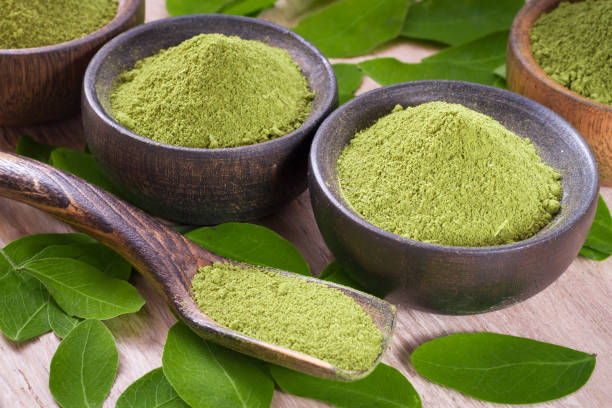
Frequently Asked Questions
Is fresh better than powder?
Fresh leaves are great if you can get them, but high-quality powders are convenient and nutrient-dense. Make sure the powder is bright green (less oxidation) and doesn’t smell musty.
Can I take moringa on an empty stomach?
You can, but some people feel queasy. If that’s you, take it with food or in a smoothie.
How long until I notice benefits?
Energy and digestion changes can show up within 1–2 weeks. Lipid and blood sugar support may take several weeks of consistent intake, along with diet and lifestyle changes.
Bottom Line
Moringa shines as a nutrient-dense, antioxidant-rich plant that can support immunity, skin health, and metabolic balance. It’s versatile, budget-friendly, and easy to add to meals or skincare. Respect it like any potent food: start small, choose quality sources, and check for medication interactions if you have health conditions.

